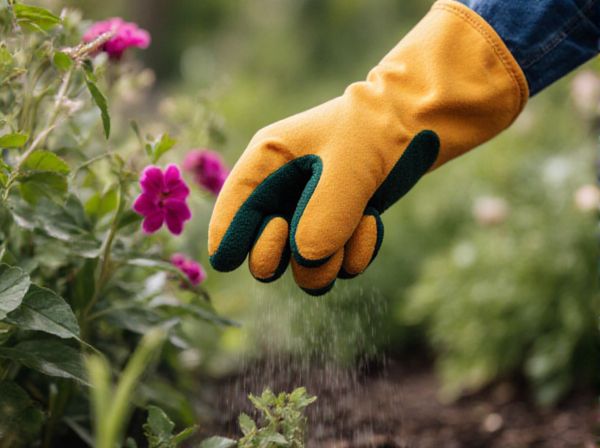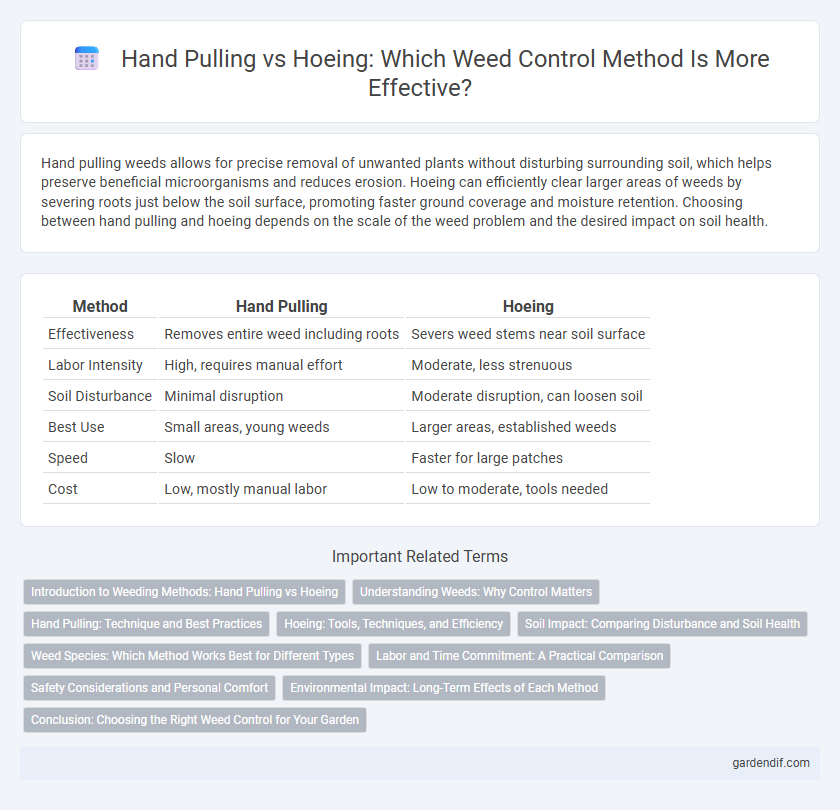
Hand pulling vs hoeing Illustration
Hand pulling weeds allows for precise removal of unwanted plants without disturbing surrounding soil, which helps preserve beneficial microorganisms and reduces erosion. Hoeing can efficiently clear larger areas of weeds by severing roots just below the soil surface, promoting faster ground coverage and moisture retention. Choosing between hand pulling and hoeing depends on the scale of the weed problem and the desired impact on soil health.
Table of Comparison
| Method | Hand Pulling | Hoeing |
|---|---|---|
| Effectiveness | Removes entire weed including roots | Severs weed stems near soil surface |
| Labor Intensity | High, requires manual effort | Moderate, less strenuous |
| Soil Disturbance | Minimal disruption | Moderate disruption, can loosen soil |
| Best Use | Small areas, young weeds | Larger areas, established weeds |
| Speed | Slow | Faster for large patches |
| Cost | Low, mostly manual labor | Low to moderate, tools needed |
Introduction to Weeding Methods: Hand Pulling vs Hoeing
Hand pulling effectively removes individual weeds by uprooting them, ideal for small gardens or delicate plants, minimizing soil disturbance. Hoeing targets larger areas by cutting weeds at the soil surface, preventing regrowth and allowing quick weed control in rows or open spaces. Both methods contribute to integrated weed management, reducing herbicide reliance and promoting healthier crop growth.
Understanding Weeds: Why Control Matters
Hand pulling targets individual weeds at the root, ensuring complete removal and preventing regrowth, while hoeing disrupts weed seedlings before they mature, reducing overall weed density. Effective weed control minimizes competition for nutrients, water, and sunlight, which is critical for crop health and yield optimization. Understanding these methods' timing and application enhances integrated weed management strategies, promoting sustainable and efficient agricultural practices.
Hand Pulling: Technique and Best Practices
Hand pulling effectively removes weeds by targeting the root system to prevent regrowth, making it ideal for small areas and shallow-rooted weeds. Proper technique involves moistening the soil beforehand to loosen roots and pulling slowly to extract the entire plant, minimizing soil disturbance. Consistent hand pulling during early weed stages reduces weed seed spread and promotes healthier garden growth.
Hoeing: Tools, Techniques, and Efficiency
Hoeing is a highly effective weed control method that utilizes tools such as stirrup hoes, draw hoes, and collinear hoes to sever weed roots just below the soil surface. Techniques like shallow slicing and repeated passes enhance efficiency by disrupting weed growth while minimizing soil disturbance. This method reduces labor intensity and improves weed management in both small gardens and larger agricultural fields by targeting weeds early and preventing regrowth.
Soil Impact: Comparing Disturbance and Soil Health
Hand pulling weeds minimizes soil disturbance, preserving soil structure and beneficial microorganisms essential for soil health. Hoeing disrupts the topsoil layer more extensively, which can lead to increased erosion and loss of organic matter but may be faster for large areas. Maintaining soil integrity by choosing less invasive weed control methods supports long-term soil fertility and plant growth.
Weed Species: Which Method Works Best for Different Types
Hand pulling is most effective for broadleaf weeds such as dandelions and chickweed, as it allows for complete root removal, preventing regrowth. Hoeing works well on annual grassy weeds like crabgrass and foxtail by severing stems just below the soil surface, disrupting their growth cycle. Understanding weed species and their growth habits is crucial to selecting the appropriate mechanical control method for optimal weed management.
Labor and Time Commitment: A Practical Comparison
Hand pulling weeds demands significant labor intensity, requiring careful root removal to prevent regrowth and often consuming more time per individual plant. Hoeing offers a faster method by slicing weed stems below the soil surface, reducing manual effort but potentially necessitating repeated applications to manage regrowth. Balancing labor input and time efficiency, gardeners choose hand pulling for precision and hoeing for broader, quicker weed control in larger areas.
Safety Considerations and Personal Comfort
Hand pulling weeds reduces soil disturbance and lowers the risk of damaging nearby plants while offering precise control, which enhances safety during weeding. Hoeing enables quicker removal over larger areas but can cause strain on wrists and back, requiring ergonomic tools and proper posture to maintain personal comfort. Wearing gloves protects hands from cuts and irritants during both methods, contributing to overall safety.
Environmental Impact: Long-Term Effects of Each Method
Hand pulling weeds minimizes soil disturbance, preserving soil structure and promoting microbial health over time. Hoeing can disrupt the soil surface, potentially leading to increased erosion and loss of organic matter with repeated use. Sustainable weed management favors hand pulling to reduce environmental degradation and support long-term soil fertility.
Conclusion: Choosing the Right Weed Control for Your Garden
Hand pulling is most effective for small gardens and young weeds, allowing precise removal without disturbing surrounding plants. Hoeing suits larger areas with shallow-rooted weeds, offering quick control but requiring regular maintenance to prevent regrowth. Selecting the right weed control method depends on garden size, weed type, and labor availability to ensure optimal plant health and productivity.
Hand pulling vs hoeing Infographic

 gardendif.com
gardendif.com